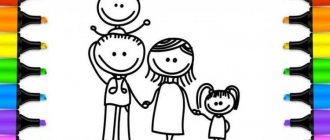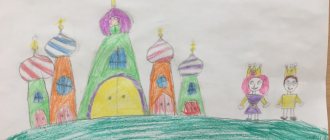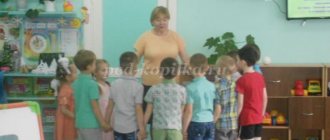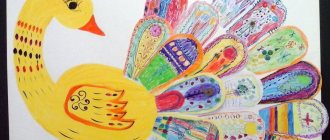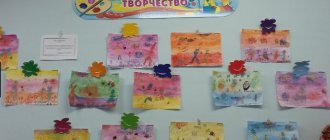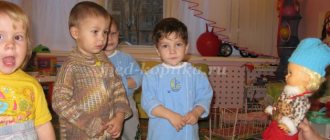Abstract of OOD on drawing in the preparatory group “My Home”
Lyubov Kuznetsova
Summary of OOD on drawing in the preparatory group “My Home”
Software tasks. Continue to develop the ability to perceive the color richness of the surrounding world and the desire to convey it in drawing. Develop the ability to search for graphic images based on observations. Strengthen the ability to actively apply previously developed methods of drawing houses of different heights and sizes. Develop conversational speech, participate in composing a story based on a drawing.
Material: Slides. page illustrations, crayons, pencils.
Preliminary work: examination of illustrations, photographs on the topic “Home”
.
Games with the constructor “Building a house”
.
Educator Game: “Pass the ball, say your street and house number”
Attention, attention, I invite you on a tour through the streets of our native village. ( Illustrations of houses and sights of the village are posted group
What kind of houses are there on the streets of our village? What is the difference? What parts does the house consist of? What do you think is the most important thing in a home?
Yes, every house, yours and others, has a roof, windows, doors, and a balcony. Now I invite you to play a game called “In order to”
. I will say the beginning of the sentence, and you will finish it.
— A house needs a roof in order to...
— The house needs doors in order to...
— The house needs windows in order to...
— The house needs a porch in order to...
— The house needs a pipe in order to...
Children answer, fantasize, and sometimes give different answers.
(The slide show accompanies the guys’ answer)
Educator: Of course, houses are very different: high and low, big and small, old and new, with large windows and small, with a triangular roof and a flat one; Every house is good in its own way, for everyone their own home is the best and dearest, because:
My relatives live there,
I can't live a day without her.
I strive for it always and everywhere,
I won’t forget the way to him.
I can hardly breathe without him,
My home, dear, is warm. (House)
So each of you has a house where you live with your family. It is probably warm, cozy, beautiful.
— Guys, I suggest you draw the house in which you live. But first, each of you will be a tour guide in your own home. Try drawing a verbal portrait of your home so we can introduce it. It was very interesting for us to listen to the description of your houses. Now, I think you can draw your favorite house .
One two three four five. (Children do jumping in place)
Let's build and play.
We are building a big, tall house. (Stand on tiptoes and stretch arms up)
What a beautiful house! (They extend their arms forward with an index gesture)
An old gnome will live in it. (Squat)
(Independent creative activity of children)
.
— Guys, I suggest you look at your drawings. We've got a whole street. Children, did you like your drawings? And I really liked it. You all worked really hard today. What did you enjoy doing most today?
Abstract of the educational activity in the preparatory group “My favorite city of Pyatigorsk” Abstract of the educational activity in the preparatory group on the topic: “My favorite city of Pyatigorsk” Integration of educational areas: “Cognitive development”.
GCD summary for speech development in the preparatory group “My Home, My Family” GCD summary for speech development in the preparatory group on the topic “My Home, My Family” Goal: To consolidate children’s understanding of family members.
Notes on drawing “My favorite fairy-tale hero” in the preparatory group Theme. "My favorite fairy-tale hero." Drawing with pencils. Tasks. Teach children to convey in drawing images of fairy tales, the characteristic features of their favorite one.
Abstract of the OOD on artistic and aesthetic activities in drawing in the preparatory group “Winter Sorceress” Program content: 1. Strengthen children’s ability to convey the colors of winter in a drawing, arrange the image across the entire sheet. 2. Develop.
Abstract of the OOD on drawing “Thumbelina” in the preparatory group for school Abstract of the OOD on drawing “Thumbelina” in the preparatory group for school Goal: to continue to develop the ability to reflect characteristic features in drawing. OOD abstract on drawing “My mother is a queen!” in the preparatory group OOD notes on drawing “My mother is a queen!” in the preparatory group Goal: to consolidate children’s knowledge about the portrait genre. Objectives: Educational:.
Summary of OOD in the preparatory group. Reading the work of S. Ya. Marshak “Cat’s House” Program objectives: Continue to introduce the works of writers, Develop interest in fiction; Improve your speech.
Abstract of OOD on design “What does it cost us to build a house” in the preparatory group SYNOPSIS OF ORGANIZED EDUCATIONAL ACTIVITY IN THE EDUCATIONAL FIELD: “ARTISTIC AND AESTHETIC DEVELOPMENT” Preparatory.
OOD on cognitive development “The House in which I live” in the preparatory group. Goal: to cultivate a caring attitude towards surrounding objects; consolidate ideas about the premises in the apartment. Preparatory work:.
Abstract of the educational activity in the preparatory group “Beloved Tyumen - my native city” Abstract of the educational activity in the preparatory group. TEACHER Stepanchuk L.P. “Beloved Tyumen - my native city” Program objectives: 1. Educational:.
Source
Drawing of a happy family, step by step with colors
What to prepare for drawing:
- album sheet A4;
- ruler for marking the proportions of the drawing;
- a simple pencil of medium hardness;
- a set of watercolors or gouaches;
- brush.
Sequence of work:
Step 1. Using a pencil, outline the main elements of the future drawing. We will use ovals to denote the contours of faces, and rectangles and straight lines to denote the torsos, arms and legs of all characters. We will draw a barely noticeable vertical line in the center of the ovals, and then divide it into three approximately equal parts with horizontal lines. Marking will help to depict facial features correctly and proportionally.
Step 2. We detail the picture. Let's draw the characters' hairstyles, eyebrows, eyes, noses, ears, lips. Let's draw the outlines of faces and figures more boldly and clearly, after which we'll slightly shade the lines. We will “dress” and “shoe” all the family members shown in the picture.
Step 3. If necessary, we will design the background and background of the drawing. Remove all unnecessary lines and markings with an eraser.
Step 4. Color the prepared sketch with watercolors, oil pastels or gouache.
Notes on drawing in the preparatory group on the topic “My Family.”
Svetlana Ignatova
Notes on drawing in the preparatory group on the topic “My Family.”
MKDOU CRR "Kindergarten No. 3"
Voronezh region, Novaya Usman.
Summary of a drawing lesson in the preparatory group “My Family ”
Author: Svetlana Vladimirovna Ignatova, additional education teacher.
1. Learn to arrange images on a sheet in accordance with the content of the picture.
2. Strengthen the ability to draw a human figure , convey the relative size of a child and an adult.
3. Practice drawing an outline with a simple pencil and then coloring it in with colored pencils. Learn independently in choosing a plot and execution technique.
4. Develop creativity and imagination. Develop the ability to see the beauty of the created image.
5. Foster a sense of respect for older family .
Material: White A4 paper, frame template, colored pencils.
Reproductions of artists' works depicting a family .
Interpretation of a drawing of a family
Options for interpretation of children's drawings on the theme “Family”:
The family members in the picture are standing close to each other and holding hands. All characters are busy with a common task or game. There are smiles on their faces, their appearance features are drawn brightly and expressively. We can conclude that mutual understanding and common interests reign in the family. The child considers it united, strong and friendly. But perhaps in this way he only shows what he would like his family to be like.
Several figures are depicted close to each other, the rest are a little further away . This is probably how the young author of the drawing imagines family relationships. It is worth paying attention to which group the child drew himself in.
One of the family members is drawn at a distance from the others. It is obvious that in real life this person keeps himself apart, distanced from family problems and the interests of the child himself. Moreover, if his facial features and other details of appearance are drawn in sufficient detail and clearly, we can assume that this person is significant for the child.
When signing the drawing, the child does not call one of the family members by name. When asked who is shown in the picture, the child calls his older brother, for example, Olezhka, and his sister, simply his younger sister. It is easy to understand that he is much friendlier to his brother than to his sister.
There are few people in the picture, but quite a lot of objects. This suggests the conclusion that the child’s attachment to the family is insufficient, that in his immediate environment, material values prevail over spiritual ones. Not everything is so simple. Perhaps, in the mind of the little artist, the world of things still prevails over emotions. Or perhaps in this way he simply communicates his desires.
The child did not draw one or more family members. This indicates obvious or subconscious negative feelings that he experiences towards these people: fear, resentment, jealousy. For example, by “forgetting” to depict a brother or sister in the drawing, who, in the child’s opinion, receive more parental love and care, he seems to be denying their presence in the family.
The child himself is missing from the picture. Perhaps the author has difficulty expressing himself in his own family, does not feel emotional attachment, does not feel his own importance, and does not fully feel parental care and love.
The young artist painted only himself. If the character is large, bright, and his facial features are clearly drawn, the drawing may indicate the child’s egocentrism and confidence in his own importance in the family. If the figure is small, depicted in dark or expressionless colors, this indicates that the author of the drawing feels loneliness, abandonment and rejection. Firstborns often experience such emotions shortly after the birth of a younger brother or sister.
Both children and adults in the picture are approximately the same height. At the same time, the child often portrays himself as superior to others. This is how a feeling of rivalry manifests itself, competition for parental (more often maternal) love with sisters, brothers, and another parent.
One of the characters is noticeably taller than the rest. This is how children portray the most powerful, significant and authoritative family members for them, usually one of the parents, grandparents. “Whoever is taller is in charge,” the child thinks something like this.
Brothers/sisters are depicted at a distance from the figure of the author of the drawing. They can also be drawn between other family members or delimited by objects. This is a signal of problematic, conflicting relationships between children and competition for parental attention.
The character is drawn with sharp strokes, intermittent contours, and with strong pressure. The image is dominated by gloomy, dark, expressionless tones. It can be assumed that this family member causes anxiety and negative emotions in the child, suppresses him, and shows aggression.
GCD move.
I really love it when everyone gets together,
The table is covered with a white tablecloth.
Grandma and mom, dad and me
We are called together ( family )
.
The topic of our lesson will be “My family ”
.
What is family ? (Children's answers)
.
Educator: A family is a home , the most precious thing that every person has is the people who live together: mother, father, grandmother, grandfather, sister, brother. Relatives whom we love, from whom we take example, whom we care about and whom we wish goodness and happiness.
The family has been revered since ancient times and people have created many proverbs:
— "My home is my castle"
.
— “What is the treasure for if there is harmony in the family ”
.
— "Being a guest is good, but being at home is better"
.
— “It’s warm in the sun, good in mother’s presence”
.
— “Wormwood cannot grow without a root”
.
Didactic game “Pick up the signs”
- What are they like, people dear and dear to us?
Choose as many words as possible that tell about mom, dad, grandfather, grandmother, etc.
Finger gymnastics (friendly family )
– bent fist, alternately extending fingers.
This finger is grandpa
This finger is grandma
This finger is daddy
This finger is mommy
But this finger is me
